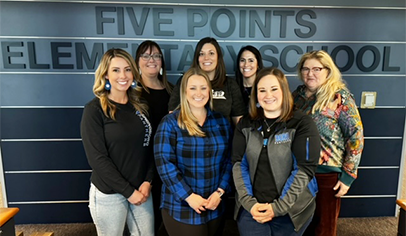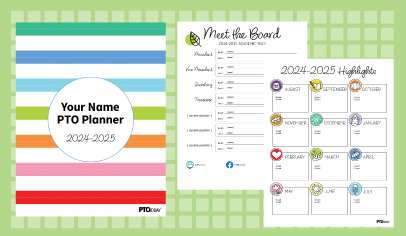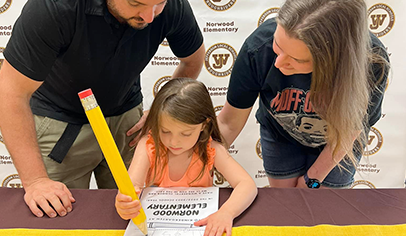The back-to-school 2023 season kicks off PTO Today’s 25th year! For two and a half decades, we’ve had a front-row seat to the work that school parent group leaders do. A lot has changed in the world in this time (we’re looking at you, Y2K), but the main focus of PTOs and PTAs hasn’t: to make schools even better places for students to learn, for teachers to teach, and for parents to become part of the community.
We flipped through the PTO Today archives for a closer look at more of what’s changed—and what hasn’t—in the past 25 years.
Recruitment
When it came to finding and keeping volunteers in January 2000, the advice was simple: “Call parents one by one. The art of volunteer recruiting is in personal selling.” That direct request is just as important today. The number one reason why people don’t volunteer is because no one asked, individually and directly; a generic, mass-emailed request for help isn’t the same as a personal appeal.
Parent and PTO Today columnist Dona DeZube offered this advice in March 2001—and we think it still holds true in 2023: “Every time someone new shows up at a meeting or calls to ask a question about joining, you must put them to work immediately and be happy with the way they do the job. If you demand that people do a job the way you would or if you redo their work, you’re never going to see them again and all the many PTO tasks are going to end up back on your to do list.”
Involvement
The following info from a survey of 1,000 parents by the Horace Mann Educators Corp. compared what respondents say they believe about involvement with what they actually do. (Think it seems recently familiar? We actually reported on it in the May/June 2000 issue.)
| What I believe: | % agreed | What I do: | % agreed |
| Parents should partner with teachers in their children’s education | 96% | I contribute funds (other than tax or tuition) to school(s) | 45% |
| Increased parental involvement is a needed educational change | 93% | I help teacher(s) in the classroom | 32% |
| Parent involvement is the one thing that can make schools more effective | 35% | I participate in our school’s parent-teacher organization | 26% |
The Elementary and Secondary Education Act was first signed into law by President Lyndon B. Johnson in 1965. But as we reported in March 2002, when the law was reauthorized a couple months prior, it added a provision for parent involvement—including requiring professional development for how to work with parents and involve them in their children’s education. Yep, parent involvement is that important!
Since the dawn of the middle school building (and probably even junior high school before that), PTO leaders have wanted to know: How do parents stay involved in the middle grades when these tweens and young teens don’t really want them around? In August 2002, our list of 15 ways to help your child’s middle school included several truly dated methods: cassette tapes, phone trees, and typing up class lists, for instance. Others might be just as relevant in their modern-day form: volunteering as a translator, staffing a welcome desk, and creating a resource center to help other parents with thorny topics around adolescence, to name a few.
Building involvement by incorporating all the diverse groups at your school isn’t a new message from PTO Today. And it’s as vital today as it was when we first wrote about it in October 2002. While an obvious first step is to translate materials for non-English-speakers, other ways of breaking down barriers include actively recruiting minority parents to serve on the PTO board, using surveys to gain insights, and making events free to attend.
In January 2003, we reported on an informal parent group leader poll: What’s your greatest PTO challenge? We bet you can guess the results before peeking.
- Getting more parents involved 68%
- Not enough time in the day 11%
- Raising more money 10%
- Dealing with principal/staff 6%
Communication
Back in the day, having a dedicated website would have put your PTO on the cutting edge. In January 2000, PTO Today founder Tim Sullivan wrote that “having a site where teachers can share homework assignments easily and where the PTO can hold interactive discussions on school issues is a whole new level of communication....The day when parents can hop on the ‘Net and check assignments for the evening and look at writing work from earlier that day is not far off.” Today, there are a number of free, easy website publishing tools with lots of bells and whistles—though it’s largely a result of the coronavirus pandemic and the 2020-21 school year that even students as young as kindergarten (and their parents) were introduced to Google Classroom, Seesaw, and other digital classroom management tools.
How do parents view your PTO—do they think of it as just a fundraising group or do they really get the impact of your group’s contributions? Putting out the right public image for your group is a matter of marketing, and in October 2002 we outlined how to do it: Define the benefits. Communicate those benefits. And use every medium available to get the message out. If you’re still struggling with your public image today, give these same tips a try.
Fundraising
At the beginning of 2000, online fundraising had just launched itself onto the scene. “In less than a year, no fewer than nine different companies have popped up, all offering a variation on the Internet fundraising theme,” Tim Sullivan wrote. Since that time, some online fundraising programs have come (hi, AmazonSmile) and gone (so long, AmazonSmile), but giving PTO supporters a way to spend money online—even if only via online payment apps—won’t be going away anytime soon.
These traits described the perfect fundraising chairperson—according to principals, teachers, parents, and fundraising professionals—in March 2001; how many of these ring true for your group today?
- Good people skills, patient, and able to deal with other volunteers calmly
- Enough time to devote to the task
- Dedicated and willing to treat the role like a business
- Good math skills and comfortable handling money
- Strong organizational skills, detail-oriented, with good follow-through
- Has a backup ready to take over in an emergency and someone in training for next year
- Unflappable—someone who won’t panic
- Experienced
As recently as earlier this calendar year, news media outlets were reporting on persistent school funding inequality and how parent group fundraisers can contribute to it. It’s not a new issue: In March 2002, our cover story asked “Can PTOs Do Too Much for Schools?” While it’s more typical for groups to cover costs for items like classroom supplies and buses for field trips, some of the groups profiled had paid for things like a new running track, a computer lab, even instructor and classroom aide salaries. More recently, some communities have tried to address the potential inequities through financial redistribution and funding limitations.
Leadership
How many PTOers does it take to screw in a lightbulb? We asked our PTO Today readers this question, and printed some great answers in the March/April 2001 issue of the magazine. We can’t decide which of these answers is the most accurate.
-
“None! We’d hold a contest and award a [shaved ice] party to the first class to accomplish the task.”
-
“Just one smart one who knows how and when to give the custodian doughnuts!”
-
“Since all the PTOers I know are great at multitasking, it only takes one. We can screw in a lightbulb, plan a teacher luncheon, set up a book fair, talk to the principal about the next bingo night, and change a diaper in the time it takes most people to buy the new lightbulb. And, when we’re done, if there’s a label on the lightbulb package that will give our school an extra 10 cents, we’ll cut it off and save it.”
-
“As many as you can possibly get! With only a few, they will eventually burn out—just like the lightbulb.”
It’s no surprise that passionate, committed parent group leaders find it hard to delegate. After all, they have a vested interest in the success of the group, and they want things done “right.” These recommendations from a time management expert are as useful today as they were in January 2001: Ask yourself, “If I say yes to this, what am I saying no to?” Follow that up with “Is there someone else who can do [this job] faster, better, just as well, or good enough?”
Teachers and Principal
A hot topic on PTO discussion forums as far back as spring 2000 was why and how to offer teacher expense reimbursements—specifically, whether teachers should get reimbursements if they don’t actively participate in the parent group. “We have a very low participation rate on behalf of our teachers, so why should we as busy parents dedicate our time to fundraising just to hand it over to non-participants?” one user asked. We at PTO Today agreed, then and now, with what this user and some others said in response: “We feel as a PTO that the teachers do their part in teaching the children. If there is a way we can help with that teaching (software, games, craft items, etc.), we are more than happy to help.”
The relationship with your principal can make or break your group’s success—or at least how stressed out you are while trying to get things done. In the August 2002 issue of PTO Today, our cover story noted that “Principals and parent group members agree the most important factor in good principal-PTO relationships is communication.” From reviewing goals at the start of the year to checking in on a regular basis, this still holds true today.

























